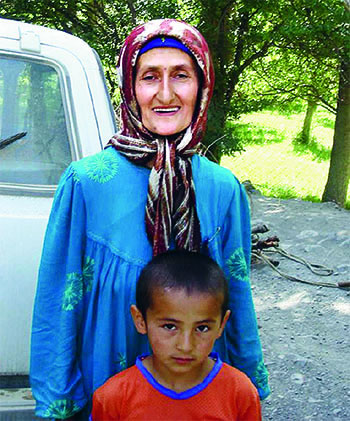Financial Crisis Adding to the Vulnerabilities of the Hungry
The recession-inspired spike in hunger is a symptom of a much deeper problem: the marginalization and disempowerment of the poorest.
Note: The views expressed in this chapter are those of the author. They do not necessarily reflect the views of IFPRI, Welthungerhilfe, or Concern Worldwide.

Fara,
Southern Madagascar
We are living on the edge. We do not understand what is going on in Tana*. The politicians there do not care what happens to the coastal populations. Many food items have become so expensive that we only consume tiny amounts of it, even fish. We eat very simple things, rice and more often cassava.
* Antananarivo, the capitalThe world is currently experiencing both a food and a financial crisis, which are linked in complex ways through their implications for food security, financial and economic stability, and political security. Because developing countries are more integrated within world markets through trade, investment flows, and remittances than in the past, the latest food and financial crises have stronger effects on those countries than during previous crises.
The impact is also stronger on the poor and hungry, many of whom are now more closely linked to the wider economy. The International Food Policy Research Institute (IFPRI) estimates that recession and reduced investment in agriculture could push 16 million more children into malnutrition in 2020 compared with continued high economic growth and maintained investments (von Braun 2008). Given that children’s undernutrition affects their physical and cognitive development and has implications for their earnings as adults (Hoddinott et al. 2008), the crises will have long-lasting negative implications for people’s livelihoods and economic prospects long after prices come down and the financial crisis is resolved.
The financial crisis and the resulting global recession pose direct threats to developing countries and transition economies in several ways:
- Falling world trade volumes and changes in terms of trade. The decline in global demand for goods and services has severely hurt food exporters around the world. The decline in exports has also reduced government revenues, which often depend heavily on export revenues in developing countries. Commodity exporters have experienced an additional blow because of falling terms of trade (falls in the price of exports relative to the price of imports), which limit their ability to import.
- Falling foreign direct investment and portfolio investment. Downturns in investments from abroad limit the already scarce capital and technology in developing countries. Large projects are put on hold or brought to a halt, unemployment surges, and jobs are lost among people in poor households.
- Falling remittances. A decline in remittances directly reduces household income in developing countries, lowers human capital investments, and impedes households’ ability to cope with food price hikes and recession.
- Increasing gap between needs and foreign aid. Although some donor governments have increased their aid volumes, this will not be enough to meet rising needs for protecting the most vulnerable in time of crisis. Where foreign aid budgets are cut, even greater pressures are placed on the capacities of health and education systems as well as the provision of social protection.
These channels have different intensities and degrees of importance for different countries. For example, declining terms of trade hurt commodity exporters harsher, and the drop in remittances affects Latin American countries more severely. Second-round effects of the global financial crisis and recession (such as transmission of the financial crisis to other sectors of the economy and drops in government revenue) exacerbate the negative impacts on the poor and hungry.
The International Monetary Fund assessed the macroeconomic vulnerability of low-income countries to the global downturn using four areas of vulnerability: trade, foreign direct investment, aid, and remittances (IMF 2009). Countries were assigned a rank of high, medium, or low overall vulnerability, depending on how much they would be affected by the financial shock and recession.
Global Recession Aggravates Situation of the Poor and Hungry

Hojieva Jumagul,
Kuhistoni Mastcho district, Republic of Tajikistan
I have a son, who lives in Russia as a migrant. He has helped me during the past 2 years. He regularly sent money, with which we repaired our house, bought a satellite dish and provided for the wedding of my daughter. He has not sent anything for 6 months, saying that he doesn’t have a job there. Neighbours say that many people are afraid to go to Russia now. They are afraid that they will not be able to find jobs.
The countries with the highest levels of hunger are also among the most vulnerable to the global downturn (see table below). For two countries with extremely alarming levels of hunger – Burundi and the Democratic Republic of Congo – vulnerability to the global downturn is also very high. Diminished aid flows are the greatest source of vulnerability for Burundi, whereas shrinking oil revenues pose the biggest threat to the Democratic Republic of Congo.
The majority of countries with a GHI between 20 and 30 also show high or medium vulnerability to the downturn. This analysis also points to those countries that need measures to prevent exacerbation of hunger in the future. Transition economies with a low 2009 GHI (that is, a relatively favorable hunger situation) – Albania, Croatia, Kyrgyz Republic, and Moldova – are highly vulnerable to the financial crisis and recession and need to take steps to prevent an increase in hunger.
At the microeconomic level, the financial crisis has decreased demand for food and pushed food prices lower. Global food prices are still high, however, compared with levels at the turn of the millennium and remain particularly high in developing countries. The financial crunch and recession have presented additional threats to the livelihoods of the poor and hungry. Wages of unskilled workers have been cut, jobs have been lost altogether, and remittances have diminished. Many small farmers who took advantage of rising agricultural prices to invest in agricultural technologies find themselves unable to pay off their debts. Resources for the most vulnerable, such as aid from donors and social protection funds from governments, are squeezed as well.
While the poor and the hungry are in general hurt the most by the food and financial crises, the exact impacts at the household level differ widely. The nature and the size of effects depend on household characteristics such as whether the household is a net food producer or consumer, the share of food in its budget, its access to services and assets, and its vulnerability to nonprice factors (Benson et al. 2008). The direct effects of financial turmoil and the fall in export revenue and remittances are likely to be felt most by the urban poor and those employed in low-skilled manufacturing industries. Yet the rural poor are also severely affected indirectly because of the close rural–urban and farm–nonfarm linkages in many developing countries (Heady 2009). Within households, the food and financial crises also affect household members to different degrees. Crises tend to affect women more deeply and for longer because women more often lack the income and assets that could help them cope with the crisis (Quisumbing et al. 2008).
Conclusion
Policy responses to the food and financial crises must recognize that impacts differ across and within countries. Social protection strategies should be designed to mitigate the current shock for the most vulnerable, lay the foundation for sustainable recovery, and at the same time prevent negative impacts in the future. Nutrition interventions, such as school feeding and programs for improved early childhood nutrition and improved nutrition for pregnant and lactating mothers, should be strengthened and expanded to ensure universal coverage.
Footnotes
- Countries with high overall vulnerability are projected to experience a decline in real gross domestic product (GDP) of 2.5 percent or more and a decline in reserves of 0.5 months of imports or more. Medium overall vulnerability corresponds to a 0.5–2.5 percent drop in real GDP and a drop in reserves of less than 0.5 months of imports. Low overall vulnerability corresponds to less than a 0.5 percent drop in real GDP.
Countries with high overall vulnerability had reserve coverage of less than three months of imports in 2008 and could lose more than an extra 0.5 months in the shock scenario. Countries with medium overall vulnerability either currently have more than three months of export coverage and are projected to lose more than 0.5 months in the shock, or currently have less than three months of coverage and are projected to lose less than 0.5 months with the shock. Countries with low overall vulnerability currently have more than three months of import coverage and are projected to lose less than 0.5 in the shock scenario.